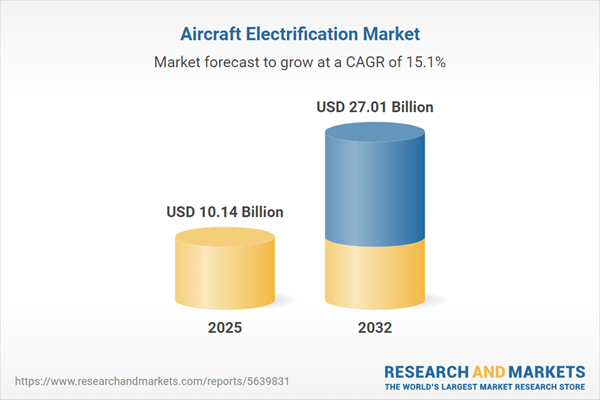Speak directly to the analyst to clarify any post sales queries you may have.
The aircraft electrification market is undergoing rapid transformation, fueled by technological breakthroughs, regulatory shifts, and growing sustainability imperatives. As the sector evolves, decision-makers face complex choices around investment, supply chains, and collaboration, all within a highly dynamic competitive environment.
Market Snapshot: Aircraft Electrification Market Size & Growth
The global aircraft electrification market expanded from USD 8.78 billion in 2024 to USD 10.14 billion in 2025 and is projected to sustain a robust 15.06% CAGR, targeting USD 27.01 billion by 2032. This growth trajectory highlights the increasing adoption of electric and hybrid systems in both commercial and military aviation, with escalating investments and cross-sector collaboration shaping future industry dynamics.
Scope & Segmentation of the Aircraft Electrification Market
Comprehensive in scope, this report examines core dimensions, market trends, and the role of technology across the aircraft electrification value chain:
- Propulsion Type: Fully electric systems (battery electric, fuel cell electric) and hybrid electric (parallel, series, turboelectric) architectures.
- Aircraft Type: Business jets, cargo aircraft, commuter aircraft, eVTOL vehicles (fixed-wing VTOL, lift-plus-cruise, multirotor), midsize commercial jets.
- Components: Battery systems (lithium-ion, solid-state), electric motors (axial flux, radial flux), power electronics (converters, inverters), thermal management systems (air cooling, liquid cooling).
- Range: Long range, medium range, short range applications, each aligned to differing operational requirements such as urban air mobility or regional transport.
- End User: Cargo operators, commercial airlines, general aviation, military users, reflecting broad adoption and diverse operational strategies.
- Regions: Americas (North and Latin America), Europe, Middle East & Africa, Asia-Pacific, with analysis by sub-region and key countries.
- Key Companies: Siemens Aktiengesellschaft, Safran S.A., General Electric Company, Thales S.A., Airbus SE, The Boeing Company, RTX Corporation, Embraer S.A.
Key Takeaways for Senior Decision-Makers
- Technology advances in battery energy density, fuel cell systems, and power electronics are driving market readiness across commercial and defense applications.
- Strategic partnerships—especially cross-sector collaborations between aerospace, automotive, and infrastructure providers—accelerate certification and deployment by addressing both technical and regulatory barriers.
- Segment distinctions, such as hybrid systems for extended routes and eVTOL for urban mobility, help organizations target innovation toward emerging opportunities and maximize operational flexibility.
- Regional initiatives in policy, infrastructure, and investment significantly shape the adoption pace, with distinct pathways emerging in the Americas, EMEA, and Asia-Pacific.
- Resilience in global supply chains and targeted onshoring initiatives are becoming increasingly important as market participants respond to evolving trade policies and logistical risks.
Tariff Impact: Navigating U.S. 2025 Policy Changes
The imposition of U.S. tariffs on key imported components in 2025 represents a pivotal inflection point, increasing landed costs and necessitating changes to sourcing and production strategy. Many aerospace manufacturers and suppliers are evaluating nearshoring and onshoring options, often balancing domestic capability expansion with the challenges of capital investment and workforce training. Engaging proactively with policymakers and exploring cost modeling strategies will be essential for managing volatility and safeguarding development timelines.
Research Methodology & Data Sources
This report leverages a balanced approach of primary interviews with industry leaders, engineers, and regulatory authorities, accompanied by rigorous secondary data analysis of technical publications and company filings. Cross-validation methods—including scenario analysis and quantitative benchmarking—ensure reliable, actionable insights on technology readiness and competitive positioning.
Why This Report Matters for B2B Strategies
- Enables informed decision-making on R&D investments, supply chain diversification, and strategic partnerships within the evolving aircraft electrification landscape.
- Provides granular insights into propulsion, aircraft segmentation, and regional strategies, supporting both short-term risk management and long-term growth planning.
Conclusion: Strategic Pathways Forward
Sustained collaboration, proactive adaptation to regulatory and market changes, and a focus on innovation will best position industry stakeholders to advance electrified aviation. This report serves as a decision-making guide for capturing emerging opportunities and navigating ongoing transformation.
Additional Product Information:
- Purchase of this report includes 1 year online access with quarterly updates.
- This report can be updated on request. Please contact our Customer Experience team using the Ask a Question widget on our website.
Table of Contents
3. Executive Summary
4. Market Overview
7. Cumulative Impact of Artificial Intelligence 2025
Companies Mentioned
The companies profiled in this Aircraft Electrification market report include:- Siemens Aktiengesellschaft
- Safran S.A.
- General Electric Company
- Thales S.A.
- Airbus SE
- The Boeing Company
- RTX Corporation
- Embraer S.A.
Table Information
| Report Attribute | Details |
|---|---|
| No. of Pages | 189 |
| Published | October 2025 |
| Forecast Period | 2025 - 2032 |
| Estimated Market Value ( USD | $ 10.14 Billion |
| Forecasted Market Value ( USD | $ 27.01 Billion |
| Compound Annual Growth Rate | 15.0% |
| Regions Covered | Global |
| No. of Companies Mentioned | 9 |









